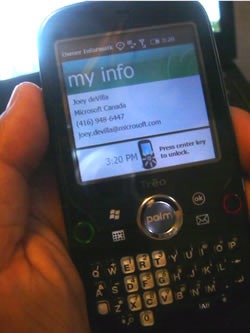The Developer Angle
In case you don’t recognize the photo on the right, it’s the “Sad Darth Vader” photo from my earlier article titled This is How the Current State of Windows Mobile Makes Me Feel. I posted it in response to The Empire’s seemingly directionless efforts with its phone platform, Windows Mobile. Or, as it’s called now, Windows Phone. Or, as it used to be called, Windows CE. Or was that Windows Embedded?
Therein lies the first problem as far as developers are concerned: finding documentation on the subject of developing for Windows Whatever-it-is-that-runs-on-phones. It’s confusing because it’s hard to even figure out what the name of the SDK you’re supposed to use is – they all sound applicable. Is it Windows CE? Windows Mobile? Windows Embedded?
(By the bye, for current phones, it’s Windows Mobile, which is based on Windows Embedded CE. Now that this new brand, Windows Phone, is kicking around, there’s a chance that it’ll get filed under that name soon.)

As an evangelist for The Empire, it’s my job to help developers figure their way around our various platforms, and I’m hard-pressed to think of a platform that appears more shrouded in mystery and confusion than Windows Whatever-it-is-that-runs-on-phones. Over the next little while, I’m going to post pointers to existing Windows Mobile/Windows Phone development articles as well as articles based on my own experiences developing for the Windows-based phone I picked up while at the recent TechReady 8 conference in Seattle. It’s a Palm Treo Pro, pictured on the left, and I chose it because out of all the mobiles at the Expansys booth (they always have a booth at the big Microsoft developer conferences), it was the one with the best “feel”.
My first pointer is to Microsoft’s own Windows Mobile 6 Documentation, located a couple of levels into the MSDN site. The main page for this section presents a giant point-and-click map of key topics for developers who want to write apps for Windows Whatever-it-is-that-runs-on-phones. I’m going to try out some of the exercises on that site and report back with stories of my experiences of getting started with Windows phone development, and whatever tips and tricks I pick up along the way.
If you’ve got any questions about developing for Windows Whatever-it-is-that-runs-on-phones, feel free to ask me, whether in the comments or via email. I may not have the answers myself, but since I’m on the inside at Microsoft, I can say that “I know a guy who knows a guy,” if you get my drift.
The User Angle
The upcoming 6.5 version of Windows Mobile – or more appropriately, Windows Phone – was announced earlier today at Mobile World Congress in Barcelona. It features a user interface that’s considerably more finger-friendly than the current 6.1, whose stylus-reliant design seems stuck in the era of the Palm Pilot. Gizmodo’s Jesus Diaz seems to really like it, as evidenced in the video he shot for his article titled Windows Mobile 6.5 Hands On: The New Interface Rocks:
Windows Mobile 6.5 Running on HTC from Jesus Diaz on Vimeo.
Diaz ends his article on a positive note, a rare thing for a writeup on Windows Whatever-it-is-that-runs-on-phones:
From this first touch on, it looks like Microsoft is back in the game. They don’t have the upper hand yet, but they are clearly waking up. We will see what happens and how deep these changes really are once it gets released.
The Developer Angle, Once More
The apparent improvements in 6.5 and promised continued improvements in Windows Whatever-it-is-that-runs-on-phones version 7 are a good sign, but a lot of the success story I’m hoping for rests with applications for these phones. For that, there has to be a developer community that has the tools, resources and encouragement to develop for Windows Whatever-it-is-that-runs-on-phones. Building that community is a challenge that I’m taking up. What can I do to help?





 The folks from
The folks from 